
RBI lowers repo rate to 6% for middle class relief
RBI cuts repo rate by 25 basis points to 6%, offers relief to middle class
In a major financial move, the Reserve Bank of India (RBI) has reduced the repo rate by 25 basis points, bringing it down to 6%. This is the second time in a row that the RBI has lowered the repo rate to help improve India’s economy, which is currently facing challenges, especially due to the impact of new tariffs imposed by the United States.
This decision was taken during a meeting of the Monetary Policy Committee (MPC). The committee had earlier cut the repo rate in February 2025 by 25 basis points as well. That was the first reduction since May 2020, making this current rate cut part of a pattern to bring relief to the economy.
The repo rate is the interest rate at which the RBI lends money to commercial banks. When this rate is lowered, banks can borrow money at cheaper rates from the RBI. In turn, banks are expected to reduce their own interest rates on home loans, auto loans, and other kinds of credit. This often leads to cheaper EMIs (monthly payments) for borrowers, which is great news for the middle-class population.
The new cut in the repo rate is expected to give a boost to consumption, encourage industries to invest more, and generally stimulate economic activity in the country.
Tariffs from the US causing economic pressure
One of the reasons the RBI decided to cut the interest rate is the economic pressure caused by new tariffs from the United States. These tariffs have raised concerns that India’s exports may decline, which can negatively impact overall economic growth.
The RBI had earlier projected India’s GDP growth at 6.7% for the 2025-26 financial year. However, these projections are now under threat because of the US tariffs. The Economic Survey released by the Indian government also gave a growth forecast between 6.3% and 6.8%, which could be difficult to achieve if the current challenges continue.
Lowering the repo rate is a way to make borrowing cheaper, which may lead to more spending and investing within the country, helping the economy to remain strong even in the face of external problems.
RBI Governor Sanjay Malhotra, who recently took charge, is expected to continue this policy of supporting economic recovery by keeping an eye on global trends while also focusing on India’s internal financial stability.
ALSO READ: Lord Ram to be consecrated as king at Ayodhya’s Ram Mandir in May
ALSO READ: IMD Warns of Heavy Rain and Thunderstorms in Mumbai for Next Few Hours
Aadhaar gets high-tech update with new app
In a separate but equally important development, the Indian government has launched a new Aadhaar app. This app aims to make Aadhaar more secure, easy to use, and accessible for every Indian citizen.
The new Aadhaar app was officially launched by Union Minister Ashwini Vaishnaw. He shared the update on social media platform X (formerly known as Twitter), saying that with this app, Aadhaar verification becomes as simple as making a UPI payment.
The app has been developed in collaboration with the Unique Identification Authority of India (UIDAI). It combines several advanced technologies, including real-time Face ID authentication and QR code-based instant verification.
This means people no longer have to carry physical Aadhaar cards or photocopies with them for identity verification. The app allows you to prove your identity instantly just by using your face or a QR scan, much like you pay digitally today.
The Aadhaar app has been built using the latest digital tools. It uses artificial intelligence (AI) to match your face with the photo in the UIDAI database. This provides a secure and fast way of confirming your identity in real-time.
It also includes QR code scanning, which can be used by banks, offices, and government services to quickly verify your Aadhaar without needing to touch or scan a physical document.
This is especially useful for people living in rural areas, senior citizens, and people with disabilities, as it removes the need for physical paperwork and makes services more accessible through just a mobile phone.
The app is expected to be useful in many sectors, including:
-
Bank KYC (Know Your Customer) processes
-
SIM card purchases
-
Government scheme verifications
-
Travel and airport checks
-
School and college admissions
-
Health insurance verifications
It will also reduce the risk of Aadhaar misuse, since there’s no need to print or photocopy the card anymore.
The bigger goal: Digital India
This new app is a part of the Indian government’s broader Digital India mission, which aims to make all government services and identity systems available digitally in a secure and simple way. With Aadhaar now going digital and mobile-first, it strengthens India's position as a tech-forward nation.
Minister Vaishnaw said this app will allow people to take control of their digital identity and make life easier in their day-to-day interactions with various institutions.
What people need to know
-
The app is available on mobile phones (likely both Android and iOS).
-
You will need your Aadhaar number and registered mobile phone to sign in.
-
The face scan works only if your face is already registered with UIDAI.
-
QR code verification can be done even offline, making it useful in areas with poor internet.
The government is also planning awareness campaigns to help people understand how to use the app and shift to digital verification.
Both the RBI repo rate cut and the launch of the new Aadhaar app are steps toward supporting the economy and simplifying life for citizens.
The repo rate reduction to 6% is a positive sign for the middle class, who may soon see a reduction in their loan interest rates and EMIs. It also sends a signal that the RBI is committed to helping the economy grow, especially in tough global conditions caused by tariffs and trade tensions.
On the other hand, the new Aadhaar app is a strong move in favour of digital India. By removing the need for paper Aadhaar copies and bringing in face ID and QR codes, it makes identity verification faster, safer, and more modern.
With both these developments, the Indian government is trying to balance economic revival and technological innovation, creating a future where citizens have less hassle and more convenience.





